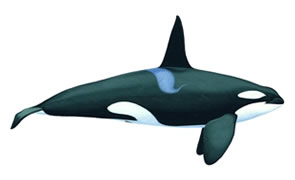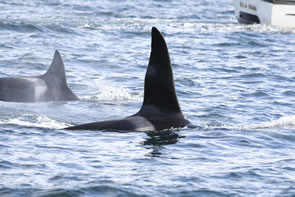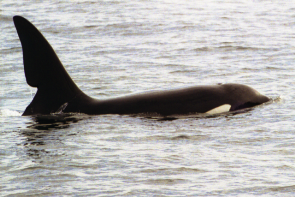Species Index


Key Facts
Length: Up to 9.5 metresRange: Global distribution
Threats: Pollution, habitat degradation
Diet: Fish, squid, birds, marine mammals


Killer Whale
Latin: Orcinus orca
Gaelic: Mada-chuain
Physical Description
Killer whales, also known as orcas, are actually the largest members of the dolphin family. Their size, colouration and behaviour make them very distinctive. Adult killer whales measure 5.5 to 9.5 metres in length and can live for up to 90 years; females are generally smaller and longer-lived than males. The robust body is mainly jet black, with a bright white lower jaw, side patch and eye patch. The belly is also white, as is the underside of the tail. There is a grey patch behind the dorsal fin, known as the ‘saddle-patch’. The adult males’ dorsal fin is the largest of all cetaceans at up to 1.8 metres and is an important identification feature. Females and young animals have a smaller falcate (curved) dorsal fin. Pectoral (side) fins in all animals are paddle-shaped.
Habitat and Distribution
The killer whale is globally one of the most widespread of the cetaceans, ranging from warm tropical waters to the freezing polar regions. There is only a small population in the Hebrides, which ranges over quite large distances, and is constantly on the move. As a result, sightings of killer whales are rare. Adult animals can be individually identified by the size, shape and distinctive nicks and markings of their dorsal fins, and HWDT’s photo-identification catalogue currently recognises about 10 individuals. However, it is likely that there are still animals in this area that have not been photographically identified. One of the most distinctive male animals, named ‘John Coe’, has been sighted regularly since 1992 throughout the Hebrides, and as far away as County Donegal in north-west Ireland in 2004, and off the Pembrokeshire coast, south Wales in 2007 and 2008. There are currently no matches between killer whales sighted in the Hebrides and those seen in Iceland, Norway, Shetland or Orkney, although there may be offshore populations which behave differently. View the Killer Whale Photo-Identifiction Catalogue.
Behaviour
Encounters of killer whales in the Hebrides are rare. Groups of up to 8 animals have been recorded off the west coast of Scotland; group sizes are significantly smaller than those recorded in other parts of the world. Different combinations of killer whales known to HWDT have been seen together again and again over many years; group composition appears to be fluid and can change between years. Killer whales are powerful swimmers capable of speeds of 35 mph, which enables them to travel vast distances in a short space of time. These animals are very intelligent and can be inquisitive and approachable. They rarely bow-ride, and in other parts of the world can be seen wake riding, breaching, spy-hopping (just the head coming out of the water), flipper splashing and lobtailing (slapping their tail-fin down on the water). However, in the Hebrides, observed killer whale behaviours tend to comprise lower levels of surface activity. Aggression within a pod is rare and there have been no recorded incidents of aggression towards humans in the wild.
Food and Foraging
The killer whale is one of the ocean's top predators. Different pods of killer whales have different feeding preferences, but worldwide, prey includes fish (including cod, herring, mackerel and salmon), shark, octopus and squid, as well as birds, seals and other cetaceans. They often hunt co-operatively and in silence, especially when pursuing marine mammal prey. It is unclear what killer whales in the Hebrides feed on, although HWDT has one confirmed report of an animal killing a harbour porpoise. Around Shetland and Orkney, killer whales have been recorded feeding on seals.
Status and Conservation
As an apex predator at the top of the food chain with no natural predators, killer whales are at risk of a higher level of toxic contamination in their tissue and organs than other species. Organochlorines (pesticides) that run-off the land into the sea, accumulate in the bodies of all marine animals. Killer whales therefore have higher concentrations of such contaminants. This species may also be affected by changes to the ecosystem, such as changes in prey availability caused by pollution and climate change. Killer whales are protected under UK and EU law, principally under Schedule 5 of the Wildlife and Countryside Act 1981, the Nature Conservation (Scotland) Act 2004 and by the 1992 EU Habitats and Species Directive.





